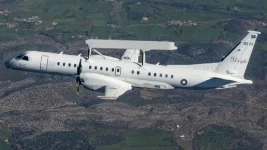- Views: 1K
- Replies: 14
The nature of conflict along India's borders with Pakistan has significantly changed due to the growing use of drones. Frequent drone intrusions from Pakistan, especially over the Line of Control (LoC) and the international border in Punjab and Jammu, highlight a critical requirement for India.
Experts suggest that India must develop or obtain a specialised defence system, known as a Counter-Rocket, Artillery, and Mortar (C-RAM) system, to counter these airborne threats.
Such technology would greatly improve India's capacity to protect its airspace, as well as vital military and civilian installations, from attacks carried out by drones.
Pakistan is increasingly using drones as a key strategic instrument for various purposes. These include direct attacks, known as kinetic operations, and other activities such as smuggling narcotics, weapons, and fake money across the border.
Amidst heightened tensions in 2025 following 'Operation Sindoor', Pakistan reportedly deployed hundreds of drones, some of Turkish origin, to attack Indian military sites in 15 different areas, stretching from Srinagar to Bhuj. These events show Pakistan's increasing dependence on large groups of drones, or 'swarms', to challenge India's air defence mechanisms and collect information.
India currently possesses an Integrated Counter-Unmanned Aircraft System (C-UAS) Grid along with air defence systems like the S-400, Akash, and the Defence Research and Development Organisation's (DRDO) D4 (Drone, Detect, Deter, and Destroy) system.
While these systems have managed to counter many drone threats, the large number and continuous nature of drone intrusions point to existing limitations in dealing effectively with small, low-flying UAVs.
The challenge is further intensified by Pakistan's partnerships with Turkey and China in producing advanced drones, such as the YIHA-III and Burraq models. These drones are equipped for surveillance, precise attacks, and electronic warfare, adding to the complexity of the threat.
A C-RAM system, exemplified by technologies such as the American Phalanx or Israel's Iron Dome, is specifically engineered to identify and neutralise incoming rockets, artillery fire, mortar rounds, and low-flying aerial threats with great accuracy and speed.
Traditional air defence systems are generally designed to handle larger threats like missiles or aircraft. In contrast, C-RAM systems are particularly effective against small, fast-moving drones that fly at low heights and are often missed by standard radar systems.
Introducing such a system would enhance India's current layered air defence structure, which already includes the S-400 for long-distance threats, the Akash system for medium-range, and the Spyder system for short-range protection.
Implementing a C-RAM type system would offer several key benefits for India's security:
- Swift Action Against Low-Altitude Threats: Many drones operate below the detection range of conventional radar, posing a challenge for systems like the S-400 or Akash. C-RAM systems, fitted with sophisticated radar and electro-optical sensors, are designed to identify and neutralise these threats instantly.
- More Economical Defence: The use of large numbers of drones by Pakistan appears aimed at exhausting India's air defence supplies by triggering the use of costly interceptor missiles. C-RAM systems, which can employ directed-energy weapons or less expensive ammunition, provide a more budget-friendly way to counter these threats.
- Safeguarding Border Communities: Civilian areas and villages situated along the LoC and the Punjab border are often subjected to cross-border shelling and drone intrusions. A C-RAM system could offer vital protection to civilian populations and essential infrastructure, thereby lessening the fear and financial losses caused by such attacks.
- Addressing Drone Swarm Attacks: Reports of Pakistan using 400 to 500 drones in a single coordinated effort indicate a move towards 'swarm tactics'. A C-RAM system, with its ability to automatically track and engage multiple targets simultaneously, is essential for effectively countering such large-scale drone attacks.
Its effectiveness was reportedly demonstrated during 'Operation Sindoor', where it successfully neutralised Pakistani drone swarms, including Turkish-manufactured models, drawing commendation from American warfare specialist John Spencer.
Furthermore, India's overall counter-drone capabilities have been strengthened by the Integrated Counter-UAS Grid, working alongside systems such as the Akash and the Israeli-developed Spyder.
Despite these advancements, existing Indian systems are not perfectly suited for quickly intercepting large numbers of small drones flying at low heights. Although the D4 system represents progress, its main methods involve electronic jamming and tricking drone guidance systems ('spoofing'). These techniques might not be enough against sophisticated drones that have features to resist jamming.
A C-RAM type system, which includes direct 'hard kill' methods like automatic cannons or laser weapons, would offer a more dependable way to physically destroy such threats.
India possesses the necessary technological expertise to create a C-RAM type system within the country. A potential first step could be to modernise existing air defence gun systems, such as the Schilka which uses radar-guided 23mm cannons, by equipping them with updated fire-control mechanisms and advanced ammunition like proximity-fuse rounds.
Furthermore, 'Project Kusha', a DRDO project aimed at developing a long-range surface-to-air missile system similar to the S-400, could also be designed to include C-RAM capabilities to counter drone threats.




